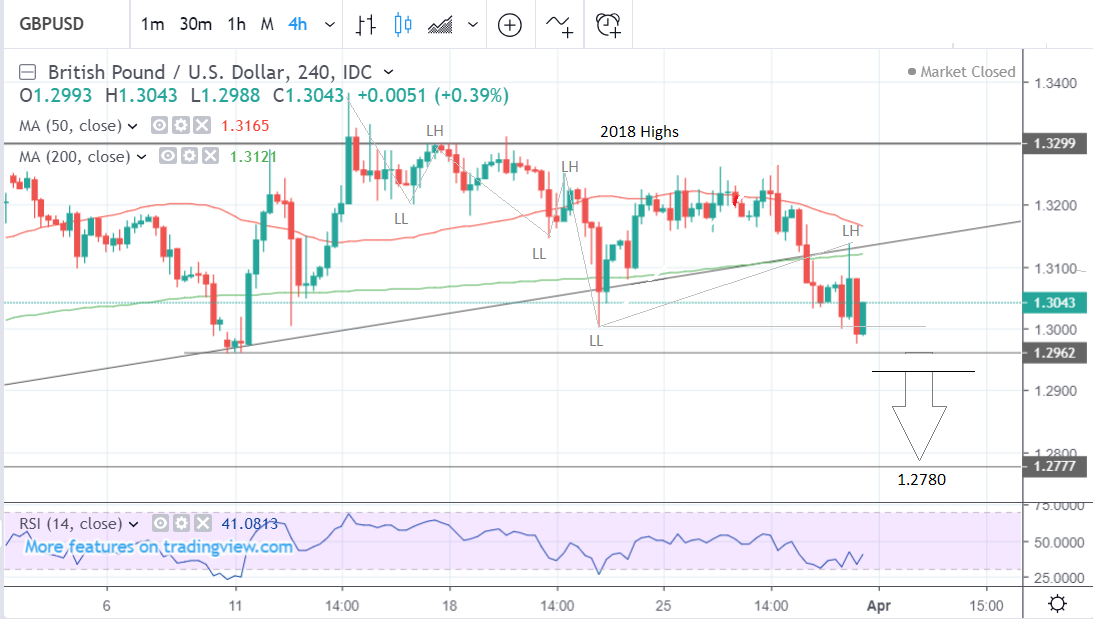The Pound-to-Dollar Rate in the Week Ahead: Trend Reversing to the Downside

© IRStone, Adobe Stock
- GBP/USD has lost ground and looks bearish
- Double top pattern at highs threatens weakness
- Sterling dominated by Brexit; USD by payrolls
The Pound-to-Dollar rate is set to begin trading around 1.3043 on Sunday after falling more than one percent in the previous week, and the eat the start of the new week, down 1.3% from the week before.
The pair fell because of heightened uncertainty over Brexit after Theresa May put her deal to the House of Commons for a third vote and still failed to get a majority, keeping the risk alive that the UK might leave the EU without a deal on April 12.
Dollar-strength also pressured the exchange rate lower after global growth concerns eased and news China’s Vice Premier Liu He will resume talks with US officials in Washington on Wednesday increased optimism over U.S.-China trade relations.
.png)
Above: Pound-to-Dollar rate shown at daily intervals.
From a technical perspective, the pair has broken below a key trendline that now threatens to break the back of a long-term uptrend. The pair has formed a possible double-top reversal pattern at the highs that is composed of two simultaneous peaks.
This is a clear sign that the recent trend may be reversing. A break below the neckline of the pattern at the 1.2950, which coincides with the March 11 low, would signal a deeper bearish breakdown and a further slide all the way down to 1.2780 and the February low.
The 200-day moving average (MA) at 1.2975 remains an impediment to further losses though, as large averages often act as a pillar of support until the market has sufficient momentum to overcome them.
A break of 1.2950 on a closing basis would provide confirmation of an extension down to 1.2780. The 4-hour chart shows that the short-term trend is bearish.
This shows the pair has started to decline in a step sequence of lower lows and lower highs. Two or more descending peaks and troughs in a row tend to be indicative of the start of a new downtrend so, the chart further supports the overall bearish forecast.

Above: Pound-to-Dollar rate shown at 4-hour intervals.
AA
The U.S. Dollar: What to Watch
The main release for the Dollar in the week ahead is the March nonfarm payrolls report, due out at 13:30 London time on Friday. Markets will scrutinise this report closely given the shockingly low 20k result last month which massively undershot the consensus for 180k new jobs to have been added that month.
Consensus is for 175k new jobs to have been added in March and for the unemployment rate to remain steady at 3.8%.If March’s figure undershoots expectations in a similar manner to last month then investors, economists and markets would likely fear for the health of the U.S. as well as global economies.
However, and almost perversely, the Dollar may not necessarily be weakened by such an outcome because of its safe-haven status and given the message such a result would send about the global economic outlook.
Wage data will also be watched closely because of the impact rising pay packets can have on inflation. In addition, with some economists growing concerned about the impact Federal Reserve interest rate rises may be having on households, wage growth is an increasingly important pillar of support for the economy.
Average hourly earnings are expected to have risen by 0.2% in March, down from 0.4% previously, and at an annualised pace of 3.4%.
Retail sales figures for February will also be released this week, on Monday, and markets are looking for growth of 0.3% in the headline number. Core retail sales, which exclude car sales from the numbers, are seen rising by 0.4%.This a key input into GDP so will help economists firm up estimates of first-quarter growth.
Another key gauge of U.S. economic health is the ISM manufacturing PMI. This index is forecast to pick up to 54.5, from 54.2 previously.
AA
The Pound: What to Watch
The main event in the week ahead for Pound Sterling will be the opening of a new chapter in the Brexit saga, with markets now focused on April 12 as the new deadline by which the UK's withdrawal must be formally agreed.
Prime Minister Theresa May now faces as choice between pursuing a so-called no deal Brexit, and requesting from the EU another extension of the Article 50 negotiating window that will almost certainly require participation in the EU parliament elections.
There is still no one path ahead that can command a majority in the House of Commons, although MPs who've been attempting to sieze control of the Brexit process from the government will get another chance on Monday to force the government into pursuing a future relationship model they find more palatable.
Some of the ideas put forward by members of parliament include a "permanent customs union", the revocation of Article 50 and another referendum among others. All of those options are likely to meet fierce resistance from the minority of Brexit-supporters in parliament, while also being electorally controversial.
There is also a possibility Theresa May could try to hold a fourth vote on her withdrawal agreement although it remains to be seen whether or not she can win it.
Apart from Brexit drama, the March IHS Markit PMI surveys will also be released, although they are unlikely to have much impact on Sterling given the market's unrelenting focus on Brexit.
Time to move your money? Get 3-5% more currency than your bank would offer by using the services of foreign exchange specialists at RationalFX. A specialist broker can deliver you an exchange rate closer to the real market rate, thereby saving you substantial quantities of currency. Find out more here. * Advertisement
